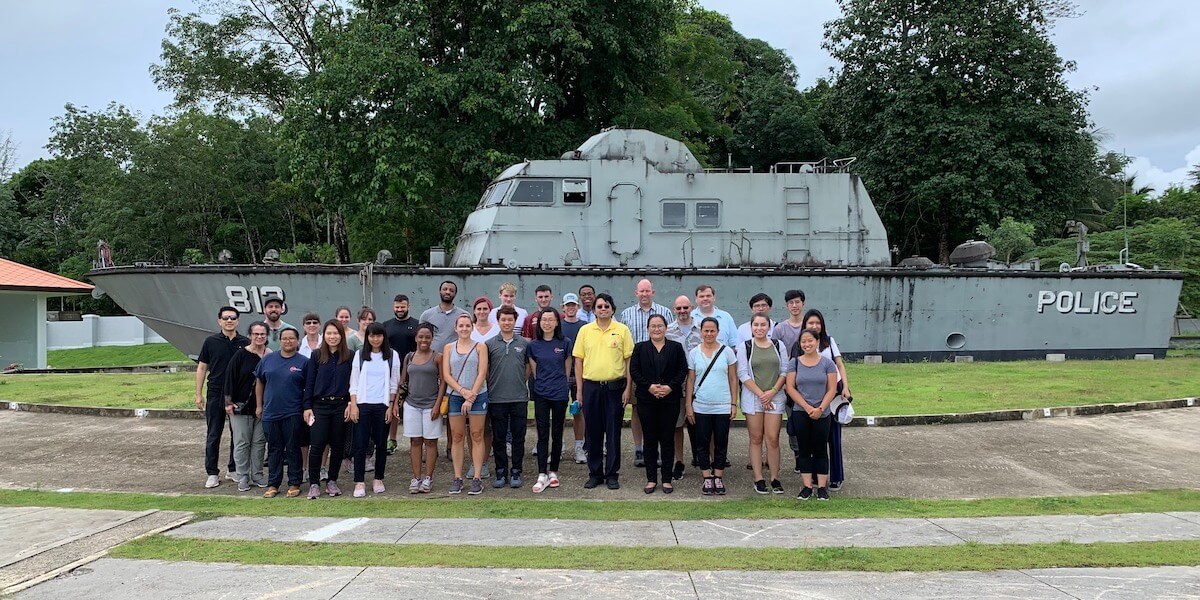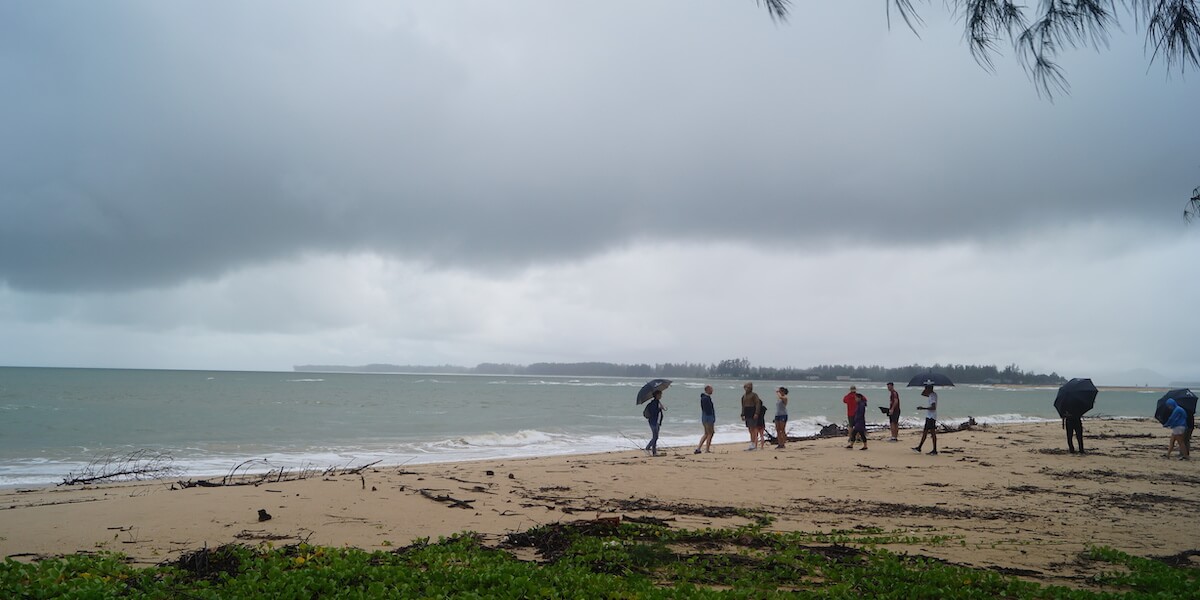
PHOTO/NATT LEELAWAT. PREEMPTIVE Participants Visit the Tsunami Memorial Museum in Khao Lak, Thailand.
The day after Christmas in 2004, a 9.1-magnitude earthquake struck off the northern tip of Sumatra in Indonesia and resulted in one of the most destructive tsunamis in history. Waves traveled across the Indian Ocean at the speed of a jetliner—over 500 mph—and hit 14 countries, including Thailand. On the shores of Phuket, locals and tourists alike followed the water outward as it receded, not knowing what was to come next. When the water came back toward them, it was too late; over 5,000 people were killed in Thailand alone.
It is this type of destruction that Erik Johnson and Gisele Ragusa of the University of Southern California and Richard Christenson of the University of Connecticut are exploring as part of their Pacific Rim Earthquake Engineering Mitigation Protective Technologies International Virtual Environment (PREEMPTIVE) projects. The PREEMPTIVE Advanced Studies Institute (ASI), sponsored by the National Science Foundation (NSF), integrates virtual learning, cross-cultural exchange and detailed seminars with practical, on-site experience.
Said Ragusa, USC Viterbi School of Engineering professor of engineering practice: “The PREEMPTIVE ASI program provides research-to-practice experiences for advanced graduate students in natural hazards research with a cultural context. By being immersed in a country where natural hazards have physical and societal consequences that are often quite dire, the students witness firsthand how their research can facilitate life-relevant changes for real people.”
This program builds on an earlier 2014 grant sponsored by the National Science Foundation (NSF) Science Across Virtual Institutes (SAVI) initiative and aims to prepare the next generation of researchers to identify and address the most critical problems related to creating sustainable and resilient infrastructure. It also provides them with a basis for inter-disciplinary collaboration.
With a focus on visiting countries that have experienced major natural disasters in the last 20 years, the program kicked off in Costa Rica in February 2019, followed by a week-long institute in Thailand this past June. The grant, which will support 80 U.S.-based Ph.D. students to participate in international exchanges, will span three years and four additional venues including New Zealand, Japan, Puerto Rico and Chile.
“These trips bring disasters to life,” said Johnson, professor of civil engineering in the USC Viterbi Sonny Astani Department of Civil and Environmental Engineering. “You can see a picture of a site or you can see it up close and from different angles, sit and talk with a local expert and learn why it was designed the way it was—and why it hasn’t been rebuilt. It’s more real this way.”
Learning from the Past
USC Viterbi Ph.D. candidate Adam Keen, whose research focuses on coastal oceanography, participated in the both of the first two PREEMPTIVE ASIs. In looking at damaged infrastructure and exploring the impact of disasters, students and faculty gathered in Thailand and in Costa Rica hoped to gain a better understanding not just of what worked and what didn’t, but about what local experts wished they had known ahead of the events.
In Phuket in June, Keen along with nine other Ph.D. students from universities across the U.S. and local Thai students from partners Chulalongkorn University and Kasem Bundit University explored the damage of the 2004 tsunami. They visited one site where it washed over the shore, as well as examined artifacts held at a museum that helped demonstrate the tsunami’s colossal destruction.

PHOTO/ADAM KEEN. Ban Nam Khem Tsunami Memorial Park in Takua Pa, Thailand. Takua Pa (near Phuket) is one of the places where the tsunami came ashore in 2004.
Said Keen: “In Thailand, the thing that stuck out is how natural hazard events sparked a national dialogue. Before the 2004 tsunami, they weren’t even aware tsunamis were an issue. This is part of the reason so many died. Now they are beginning to ask questions like, ‘How do we prepare for natural hazards?’ and ‘What can we do as a community or country?’”
Program participants represented a diverse range of academic areas, including cultural anthropology, civil and mechanical engineering, psychology, communications and K-12 education. A key component of the ASIs is learning how to collaborate across different technical disciplines, beginning with understanding how to integrate different perspectives into a discussion from its outset.
“By immersing themselves in real-life scenarios, the students begin to understand that their research is situated in physical, economic, cultural and socio-political contexts and that each of these elements is of equal importance,” Ragusa said.
In February 2019, prior to visiting Thailand, students and faculty traveled to Costa Rica. There they visited one of several active volcanoes and examined a number of bridges damaged in the 1991 Limón earthquake that have yet to be repaired. One of the bridges they examined continues to support trucks bearing heavy loads, despite a hinge that left the entire structure’s stability in question. At times, rocks would be hammered into the gap in the structure as a makeshift reinforcement. To Johnson, it was clear that one more quake would completely shatter the structure. If it did so, San José would be completely cut off from the port and thus lose access to their largest source of goods transported to or from other countries.
One of the key similarities between Costa Rica, Thailand and the U.S. observed by participants was the need for greater investment in infrastructure. It was also clear communication strategies were needed to emphasize and spread the importance of preparedness and clarify which steps should be taken in the event of a major disaster.
“What might not be an emergency today could be one in the near future,” Johnson said. “It’s important to examine these issues on a global scale and bring back lessons learned that parallel problems we have here.”
In many cultures, students and faculty learned, disaster preparedness is not a part of the academic, political or social framework. A large reason for this is that most disasters happen after a long period of dormancy. “People are still learning how to navigate issues like how to communicate to their families they are safe,” Keen said. Generations grow up between major events and feel no impetus to prepare for the next disaster. Since the 2004 tsunami in Thailand, there is more focus on research and identifying better evacuation routes and other strategies to mitigate such a large scale of deaths.
“From a societal point of view, the key takeaway is we need to educate people and we need to be prepared. This links directly back to Los Angeles. Are we prepared for the next disaster? Hurricane Katrina was a mess. Are we going to be any better off when the next major earthquake hits?” said Johnson.
The PREEMPTIVE program will continue with its next ASI in New Zealand in January 2020. Twenty-five graduate students from universities including USC, the University of Connecticut, UC San Diego, the Georgia Institute of Technology, the University of Illinois at Urbana-Champaign and others participated in the first two trips. Partner universities included Chulalongkorn University and Kasem Bundit University in Thailand and the University of Costa Rica in Costa Rica.
This work is funded by the National Science Foundation under grants OISE 18-29085/18-28948 (Dr. Fahmida Chowdhury, Program Director).
VIDEO/COURTESY OF THE UNIVERSITY OF Costa Rica PREEMPTIVE participants from the U.S. and partners from Costa Rica examine and discuss damage from disasters, including the historic Limon quake.
Published on August 29th, 2019
Last updated on April 8th, 2021







